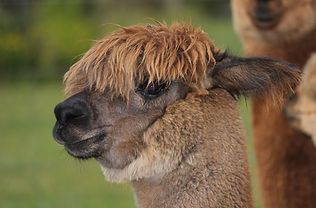ALPACAS
Alpacas are members of the Camelid family that includes llamas, vicuna, guanaco and camels.
Alpacas are native to the Andes Mountains of South America.
They were domesticated centuries ago by the Inca people by whom they were highly valued.
Alpacas are relatively small animals weighing 55-80kg. They are gentle and inquisitive in nature.
While they look cuddly with their long necks, big dark eyes, velvety noses and woolly coats, most alpacas don't really like being held and particularly don't like to be touched on their heads.
A baby alpaca is known as a cria. They are most commonly born in the morning after an 11½ month pregnancy
and weigh 6-8kg. Delivery is sometimes referred to as 'unpacking'!




Alpacas neared extinction during the Spanish invasion of South America in the 16th century.
Their survival is attributed to their resilience in the harsh climate high in the mountains where introduced cattle and sheep could not survive. Alpacas were originally imported into Australia by Charles Ledger in the mid 1800's, however the venture was not a success and it was not until the 1990's that alpaca farming started to prosper in Australia.
Alpacas have a low impact on paddocks. They have soft pads rather than hooves resulting in little environmental damage. They graze gently, nibbling the top of pasture grass rather than pulling the roots from the ground, resulting in faster regrowth. Their poo is an excellent fertiliser and they conveniently drop it in piles making for easy collection while also reducing the risk of spreading disease as the rest of the paddock is clean for grazing.
There are two types of alpaca – hyacaya (wua'ki'ya) and suri (soo'ree). The differences between the two types are found in their fleece. Huacaya alpacas have a soft top knot on their head and fleece on their cheeks. The fibre on their bodies is dense and crimped and it grows straight out from the skin. Suri alpacas have lustrous silky locks of fibre that hangs like a curtain from a central part that runs from their neck to their tail.
Alpacas are shorn once a year in Spring. They feel more comfortable over the warmer months with their fleece removed and the fibre regrows by the time the cooler weather sets in.
Alpacas are bred in Australia for their fleece and as stud animals, as pets, as herd guards against foxes and less commonly - cover your ears - for meat.
Alpacas sit by folding their legs under their bodies. This neat little position is called cush.
When excited, alpacas pronk around the paddock. Pronking is the alpaca equivalent of skipping – a boing, boing spring-like run where they lift all four feet off the ground at once. Watching a group of cria pronking together at dusk is a most heartwarming sight.
Alpacas do spit – usually at each other and only if provoked. Alpaca spit is a mixture of saliva, stomach acid and green digesting hay – it has an unpleasant lingering smell and is best avoided if possible!
Alpacas are closely related to llamas. The main differences are that llamas are approximately twice the size of alpacas, they have banana shaped ears and longer faces than alpacas and were principally used as pack animals. Llamas are more recently being bred for fibre.
Whisper - bottom left - is a friendly girl who is usually up for a cuddle.
Martina - centre bottom - peering at the house in hope of some pellets.
Rosie - bottom right - another friendly girl with her wild top knot - she was the model for our business logo.



